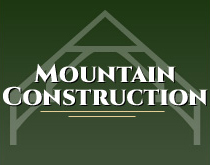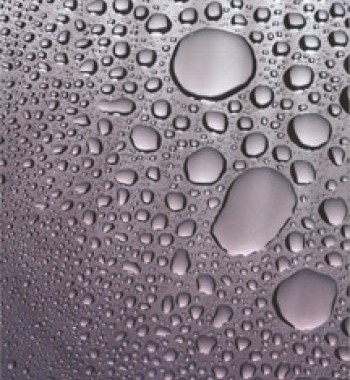For information on green building or a free consultation contact Mountain Construction
By Stacy Hunt
Reprinted from Green Builder Magazine, October 2010,
Before I begin, I have a confession to make. I'm an energy bigot.
Most of my work is in the energy and environmental construction industry, dealing with engineers, analysts, researchers and policy makers. In my world, it's as simple as this--sustainability in the house as a system starts with energy efficiency. Without proper consideration for energy efficiency, talking about other attributes of sustainability is worthless.
No one wants to hear about the relative sustainability of rapidly renewable flooring versus old-growth wood flooring when his or her house has more air leakage than the neighboring barn.
When asked to write an article about "plumbing system sustainability," I was intrigued. Not only are the energy impacts of plumbing systems significant, but the water use impacts (second only to energy) are also noteworthy. In addition, there are significant environmental impacts of residential plumbing systems--namely, the manufacture of the multitude of products (equipment, piping, fittings, fixtures), their durability (after all, it's not sustainable if you have to replace or remodel it quickly), hot water, and the management of waste-water.
You'll find that this article largely focuses on the core components associated with plumbing systems in residential buildings--pipe and fitting selection, fixture selection, and hot water production and distribution. However, this information is really just a drop in the pond, and there are a ton of bright folks out there who have produced volumes of informational and educational material intended to help you best design your plumbing systems.
Theory and Practice
Energy use is both quantifiable and significant in the sustainability picture. The U.S. Environmental Protection Agency (EPA) estimates that at least 3% of our electric energy use is associated with simply moving and processing drinking water and providing wastewater utilities. That's approximately 56 billion kilowatt hours (kWh) or the equivalent of 45 million tons of greenhouse gas per year. At least 20% of all energy consumed in homes is used to heat water. This percentage continues to grow as other areas of the home like space conditioning become more efficient.
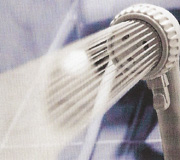 The second most important issue to address in plumbing systems is water use. As increasing populations create greater demand for fresh water, the existing supply isn't able to keep up. The World Bank reports that more than 80 countries now have major health and economic issues due to water shortages, and studies show that at least 36 U.S. states are going to suffer major water shortages within the next five years.
The second most important issue to address in plumbing systems is water use. As increasing populations create greater demand for fresh water, the existing supply isn't able to keep up. The World Bank reports that more than 80 countries now have major health and economic issues due to water shortages, and studies show that at least 36 U.S. states are going to suffer major water shortages within the next five years.
Significant water and energy savings (up to 40%) can be realized by improving the design of plumbing systems. These savings are easily attainable, and simply involve some preplanning and deliberate design techniques. Beyond energy and water savings, there are also measurable benefits of careful design and installation of plumbing systems, including:
-Environmental impact, when considering alternative water sources and treatment systems.
-Building durability, when selecting pipe and fitting materials and fixtures.
-Occupant health, when evaluating hot water sources and supply line materials, and secondary plumbing systems, such as radon mitigation and central vacuum systems.
-Occupant safety, when considering residential sprinkler systems.
-Convenience and ease of use.
"Customers want service, provided efficiently," says Gary Klein, a well-known expert in hot water system efficiency and managing partner of Affiliated International Management. The first concern of an occupant is getting water when they want it, at the temperature and volume they want. Second, they want to know it's delivered efficiently. If you can't meet the end use needs of the customer, it simply doesn't matter how great the parts of your system are when evaluated individually.
Pipe and Fittings Material Selection
When evaluating pipes and fittings, material selection is critical for a variety of reasons, including durability, embodied energy, and the overall carbon footprint in product manufacturing. Water quality can also be affected by the materials, so the health and welfare of the occupants is also a concern. While there are a variety of materials available, and each has pros and cons, it's difficult to find a comprehensive, comparative life-cycle analysis of plumbing materials that would allow for an apples-to-apples comparison. Ultimately though, newer, lighter, and more efficiently produced materials will carry less of an energy and environmental burden than heavier, more manufacturing-intensive materials. However, corrosion resistance and leaching are a concern in some products. Here's a quick overview of material types to help get you started on your own evaluation of pipes and fittings:
Polyvinyl Chloride (PVC) is a plastic material frequently used for water service to the home from the main, 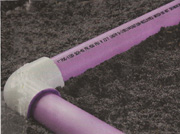 swimming pools, and sprinkler drain systems. PVC contains phthalates, which are controversial in terms of long-term health effects, particularly in infant exposure. Although it's unclear whether the use of PVC piping can increase human exposure to phthalates to a significant degree, PVC has other issues. Lead is sometimes used as a hardening agent in PVC during the manufacturing process. On the positive side, Chlorinated PVC (CPVC) offers better corrosion resistance in situations with high acid water.
swimming pools, and sprinkler drain systems. PVC contains phthalates, which are controversial in terms of long-term health effects, particularly in infant exposure. Although it's unclear whether the use of PVC piping can increase human exposure to phthalates to a significant degree, PVC has other issues. Lead is sometimes used as a hardening agent in PVC during the manufacturing process. On the positive side, Chlorinated PVC (CPVC) offers better corrosion resistance in situations with high acid water.
Copper is one of the most commonly used piping materials because of its availability and durability. Copper can corrode in the presence of high aced water and like PVC, may contain lead. States like California and Vermont have dramatically lowered the lead permissible in plumbing fittings down to 0.25%.
Galvanized Steel isn't commonly used anymore because of its high tendency to corrode and short service life. As many homeowners and remodelers can confirm, galvanized steel is often the motivating factor for changing out entire plumbing systems in older homes because of corroded galvanized piping. In addition to internal corrosion, which causes restricted water flow, other metals used in valves and fittings can cause galvanized steel to corrode more rapidly.
Cross-Linked Polyethylene (PEX) is a flexible plastic pipe that is highly freeze-resistant and allows for fewer fittings than rigid piping systems. "Fewer fittings means less pressure loss," says Shawn Martin, director of industry relations for the Plumbing, Mechanical & Fuel Gas group of the International Code Council. "This may make it possible to drop the pipe size, reducing the enclosed volume." PEX has a high durability and low corrosion because of its complex molecular formulation. However, PEX must be kept out of direct sunlight, as ultraviolet radiation degrades it over time.
Other Materials include PE-RT (just approved for use in the 2012 International Plumbing Code), polypropylene, and polyethylene.
Hot Water: Waste Not
Water and energy efficiency hinges on the amount of water used for tasks. Using low-flow fixtures and proper use configurations can significantly improve plumbing system efficiency. The easiest way to select good fixtures is to follow some of the well-established fixture efficiency guidelines, like the EPA's WaterSense labeling program, which requires that labeled fixtures provide a measurable, third-party certified 20% improvement in efficiency over average products in the same category.
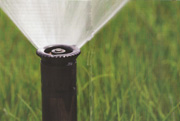 That said, simply selecting low-flow fixtures doesn't cut it. Ultimately, if we expect our occupants to behave responsibly in terms of their water use, we have to recommend truly sustainable installations as well as low-flow fixtures. Three shower heads or a 102-gallon tub are not the picture of sustainability, even when the fixtures themselves are water-efficient.
That said, simply selecting low-flow fixtures doesn't cut it. Ultimately, if we expect our occupants to behave responsibly in terms of their water use, we have to recommend truly sustainable installations as well as low-flow fixtures. Three shower heads or a 102-gallon tub are not the picture of sustainability, even when the fixtures themselves are water-efficient.
Hot water delivery to fixtures by means of the water heating and distribution systems is critical in the energy and water profile of the home. Lengthy (and uninsulated) distances or "runs" between water heaters and fixtures cause a significant amount of water to be wasted simply waiting for hot water to arrive at a shower or faucet. When the tap is turned off, the unused hot water in the pipes causes energy to be lost.
According to Klein, the problem started with a well-intentioned solution, building regulations. "There were two sets of regulations," says Klein. "the plumbing codes and the federal energy regulations. Plumbing codes required bigger diameter pipe to maintain proper pressure when there are more fixtures on a given line. Federal energy regulations limited fixture flow rates, plus other federal regulations reduced flow rates to appliances. As bigger houses were built, more pipe and fixtures were needed, requiring bigger diameter pipe." This poorly engineered solution resulted in occupants having to turn the tap on and then wait for warm water to arrive. Now, instead of 5 seconds to get hot water it takes about 18 times as long, or 90 seconds.
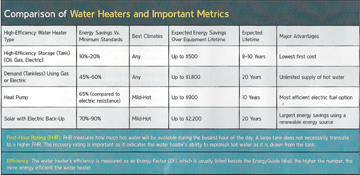 In addition, supply and drain issues were introduced, as piping remained the same while flow from fixtures decreased. There's no other polite way to phrase the real problem here--there often simply isn't enough water to flush the poop without changing drain pipes or slope.
In addition, supply and drain issues were introduced, as piping remained the same while flow from fixtures decreased. There's no other polite way to phrase the real problem here--there often simply isn't enough water to flush the poop without changing drain pipes or slope.
Strategies to address problems in water distribution clearly vary in new and existing housing. In new construction, there are a slew of strategies to ensure efficient hot water distribution, since you're starting from scratch. Of these, creating a central core plumbing system is the simplest, most effective method. Stacking second floor bathrooms on top of first floor baths, kitchen, and/or laundry areas creates these central cores and helps to reduce the amount of time it takes for hot water to reach the desired end. Main trunk lines feed the central areas from core water heaters. In cases where water use areas are separated by a great distance in the house, multiple cores can be built using separate trunks and multiple water heaters.
According to Klein, overall system efficiency is greatly impacted by the effectiveness of the task--whether or not the customer is getting the desired result. "The big driver related to sustainable practices on the hot water side is that [system efficiency] ends at the hot water outlet--the faucet, the shower," says Klein. "If the plumbing in the middle is not effective in delivering hot water efficiently you simply can't save as much water as you think you can." Same goes for cold water lost waiting for hot--waste.
"The bottom line," says Martin, "is minimizing the amount of water lost down the drain while you wait for water to warm up." I can substantiate this. In our master bathroom, which is on the other end of the house from our (highly efficient, mind you) on-demand hot water heater, I run nearly four gallons of cold water down the drain waiting for hot water to arrive. Double that to account for another shower each day (that's not even accounting for the teenagers we'll have in not too many years) and you've got more than 2,400 gallons of perfectly good water lost each year in my home.
In a retrofit situation like this, using a demand-controlled recirculation pump on the far end of the house where all of the water uses are located (master and kid's bath) would eliminate this loss. According to Klein, this strategy uses the least energy, wastes the least water, and is the most cost effective option for the application.
Really, any strategy to address these losses in retrofit is a good thing. Because, honestly, unless you're focused on major rip-out-the-floors-and-walls retrofits, you're not changing out the piping, you're just replacing component parts. On the topic of retrofit--look for the leaks. The EPA estimates that about the same amount of water used for the people of Los Angeles is lost in water leaks each year.
Hot Water System Equipment Selection
In the past, storage (tank) water heaters were the most common type of equipment. Recently, demand-based (tankless) water heaters have become more common, and both heat pump and solar water heaters are available. The following options are available to install in new or to retrofit older homes:
Storage (tank) water heaters are significantly more efficient than they used to be (check the specific  model/manufacturer, as efficiency may vary based on fuel type and technology), but they're still less efficient than most demand-based systems due to standby heat loss and energy use.
model/manufacturer, as efficiency may vary based on fuel type and technology), but they're still less efficient than most demand-based systems due to standby heat loss and energy use.
Instantaneous (tankless) water heaters though improperly named, according to Klein, because the heater doesn't (usually) instantaneously begin with hot water, eliminate standby losses and can significantly reduce energy use. These systems heat water only when there is a call for hot water from the system. It's critical with tankless water heaters to consider required hot water flow rates, and to ensure (as with any system) that distances from the heater to the fixtures aren't too great (or if they are, they're adequately addressed by recirculation or supplemental heating).
Solar (and solar assisted) water heating systems heat water using the sun's energy. They can reduce energy use by up to 90% in some areas but are useful even in cloudy and northern climates. Remember that the sun has its own time frame for providing energy, and the occupant's water use is on a different clock. You're likely to need a supplemental heater with your solar system, because at a minimum, you'll want hot water at night, and the system may not accommodate your needs on its own.
Heat pump water heaters use electricity to move heat rather than generating heat themselves. Ground source heat pumps, for example move warm ground temperatures into the home in the winter to provide heating and move warm indoor air out of the home in the summer to provide cooling.
Combination units provide both space heating and hot water in one system, eliminating the need for two separate systems. These systems use a blower (which blows air over a hot water coil and into the home's ductwork) or a hydronic radiant heating system (which uses water piping installed under floors or in baseboards). It's especially useful for those with limited space for mechanical systems, and provides improved efficiency.
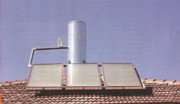 Drainwater heat recovery systems do just that: recover heat from hot water that's traveling down the drain via a simple water pipe coil that is fed back to the water heater. This reduces the amount of work the heater must do to get hot water to temperature. Since a significant amount of hot water in homes is used for showers, that's a great location for a heat recovery system. However, residential systems are challenged because of lesser water flow and the need for storage tanks, which aren't needed in commercial applications.
Drainwater heat recovery systems do just that: recover heat from hot water that's traveling down the drain via a simple water pipe coil that is fed back to the water heater. This reduces the amount of work the heater must do to get hot water to temperature. Since a significant amount of hot water in homes is used for showers, that's a great location for a heat recovery system. However, residential systems are challenged because of lesser water flow and the need for storage tanks, which aren't needed in commercial applications.
First-Hour Rating (FHR). FHR measures how much hot water will be available during the busiest hour of the day. A large tank does not necessarily translate to a higher FHR. The recovery rating is important as it indicates the water heater's ability to replenish hot water as it is drawn from the tank.
Efficiency. The water heater's efficiency is measured as an Energy Factor (EF), which is usually listed beside the EnergyGuide label; the higher the number, the more energy efficient the hot water heater.
Outdoor Use
Some sources say that up to 56% of water used around the home in the summer is used to irrigate lawns and gardens (depending on location/irrigation needs).
Installing and properly configuring sprinkler systems can help conserve water, but deliberately considering landscaping strategies, and plant and grass choices can also reduce outdoor water use tremendously. Zoning isn't just for heating and cooling systems--exterior plantings can be zoned to ensure that the most water intensive gardening occurs in a small area close to the home, land that other landscape attributes are xeriscaped to reduce water consumption. Considerations for greywater reuse become paramount in areas with low rainfall, and can provide water for planting beds close to the home.
Smart irrigation controls tailor water applied to the needs of the plants, incorporating data from weather, soil conditions, and climate to determine when to water and how much.
Water Softening and Filtration
A hot issue, water softening and water filtration have both pros and cons in regard to sustainability.
Water softeners extend the life of equipment and appliances by removing the potential for buildup in pipes and sensitive equipment.
However, in some cases, over softening can cause salty water, which can be aggressive to certain sensitive system components.
In addition, places like California are considering bans on softeners because of the salt they deposit into municipal systems.
The verdict is still out on this one--no one seems to have a conclusive, scientifically valid answer to the question of acceptable salinity levels.
As for filtration, in some cases it is necessary because of poor water quality, but the sheer volume of water wasted being processed in systems like a reverse osmosis filter are enough to make you wonder about the net gain—and their long-term sustainability.
Ultimately, the efficiencies on water softeners as well as water filtration systems can be extremely low, so it's important to understand the need and the system before installation.
Mountain Construction does custom home building in any building style, including conventional new homes, remodeling and restorations, log and timber frame home and structural insulated panel homes. Check out our site and learn more about our Construction and Remodeling services.
To find out how we can help you build or remodel your home CONTACT US.
